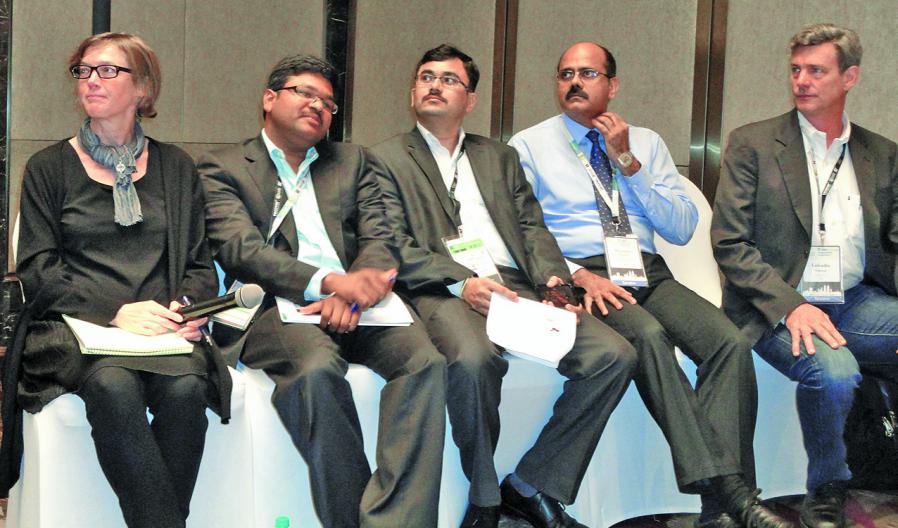
Cotton 2040 a mission in sustainability…
The Future of Cotton is something everyone is talking about and how it will impact humans, water, air and earth as well as the apparel business. “The apparel sector faces some difficult and complex challenges. If it is to transform itself into a vibrant prosperous and durable industry, securing a sustainable supply chain for cotton is key,” stated Dr Sally Uren, CEO, “Forum of the Future”, which is an independent non-profit organization that works globally with business, Government and other organizations to solve complex sustainability challenges.
Mission “Cotton 2040” is led by “Forum for the Future” and is engaging widely with stakeholders throughout the cotton and apparel industry including brands of retailers, standards, cotton producers, NGOs and more. Sally explained that while cotton is an integral part of our lives and gives livelihood to millions around the globe unless it is grown sustainably, it leaves a heavy footprint on the environment; and socially it takes more than 20,000 litres of water to produce one kilo of cotton. But the total production of more sustainable cotton is estimated at about 4 per cent of global production.
Charlene Collison, Principal Sustainability Advisor, Futures informed about the priority areas for collaborative action. “We can clearly see a number of significant risks for cotton that need an industry-wide response in the future. The challenges the industry may be facing range from high costs and supply chain failures, growing inequality and job loss, to the total extinction of the industry in some parts of the world,” said Charlene.
This story first appeared in the Apparel Online India, October 2nd Issue. SUBSCRIBE TODAY
The next phase will build plans and commitment for cross industry working groups in the key areas for collaborative action identified in the scoping stage. These are creating and building consumer demand for sustainable cotton, investing in recycling and upcycling for a circular economy and upskilling investing in local schools and communities. One will also need developing business models with new route to create value, building transparency, making the industry more resilient to shock, building regional supply chains with vertical integration and advocacy and lobbying Governments.

Sally and Charlene revealed what the biggest challenge for cotton was – price, land, technological innovation and synthetic fibres. There was a need for cooperative movement and a systemic shift, which was not rapid enough right now. “Cotton 2040” is trying to achieve, and harmonising platform to accelerate the shift and bring sustainable cotton into the mainstream. “The future is already here, only that it’s not evenly distributed and at times it is an uncertain future with roaring population, climate change, world trade and the question – should it be sustainable cotton or tea?” queries Charlene.
They explained that to better understand the challenges, a set of scenarios were developed describing plausible future worlds for “Cotton 2040”. They were – ‘slow is beautiful’, ‘techno chic’, ‘community couture’, ‘patchwork planet’, which asked the important options – ‘slow or fast’ and ‘connected or fragmented’?
So how does one do things differently? There are six steps to change, starting with: experience needed for change; diagnose the system; create pioneering practices; enable the tipping point; sustain the transition; and lastly, set the rules of the new mainstream.
The “Forum for the Future” will be working in a process of consultation and co-creation through 2015 on three points: Scope – What’s currently being done within the areas identified for collaborative action; Co-create – Recommendations with industry stakeholders into action plans for working groups; and Gain – Buy-in to action plans and agree the way forward.
Future of cellulosic materials
Speakers like Lafcadio Cortesi, Rain Forest Action Network; Krishna Manda, Senior Advisor Sustainability Corporate, Sustainability Lenzing; Sandeep Theng, Forest Stewardship Council; Shona Quinn, Sustainability Leader, Eileen Fisher; Manohar Samuel, President Marketing and Business Development, Birla Cellulose Aditya Birla; and Amanda Carr of Canopy via video conferencing updated the delegates on sustainable qualities and services of its products and how they are helping the environment and social causes.
Eileen Fisher moves ahead with Vision 2020
Shona Quinn revealed “Vision 2020” from Eileen Fisher the brand that has been following the sustainability path for a long time. “We are working toward a world in which the clothes you love to wear create nothing but love. Our vision is for an industry where human rights and sustainability are not the effect of a particular initiative but the cause of business well run,” she shared. The brand hopes to create a truly responsible supply chain. It aims to scrutinize everything from field to factory to the landfill and take a hard look at what’s often swept under the rug – toxins, carbon emissions and low worker pay. “Vision 2020” means that the first five years of the company’s plan is to get to 100 per cent sustainability. Fibres, colours, resources, people mapping, the global chain and reuse are some of the factors that the brand will concentrate on.
The company also hopes to move away from Rayon and onto Tencel, which has a better chemistry and also polyester if it’s recycled. Using less water, leaving less fabric waste, using ‘Bluesign’ certified dyes and hopes to design clothes that last and then when the customer is done with it, the brand will resell/recycle. By 2020, if the linen is conventionally grown the brand won’t use it. It’s the ‘Green Eileen’ approach along with supporting progressive forestry practices for the brand.
FSC from “Forest to Retailer”
Sandeep Theng from “Forest Stewardship Council” (FSC), which has been around since 1993 and has certified 10 per cent of the world’s forests, shared that the FSC standard is the only certificate backed up by most stakeholders in 85 countries. Sandeep explained that sourcing from sustainable forestry is one of the most effective and ethical means to initiate climate change. “Climate change is probably the biggest threat facing life on the planet. Despite the increased awareness of forest’s vital role in the survival of the planet, deforestation and forest degradation remains major problems. Brands want to prove to customers that they only buy the most ethical sourced environmentally responsible material.”
FSC recognizes that forests include the people and communities who depend on them for their livelihood, hence FSC is from “Forest to Retailer” through an unbroken chain with two certifications – Forest Management (FM) certification and Chain of Custody (CoC) certification. It is the only forest certification scheme backed by Canopy, Rain Forest Alliance, Greenpeace and World Wide Fund for Nature and sets a benchmark for forest companies and communities to follow.
Lenzing remains committed to sustainability
Krishna Manda of Lenzing revealed that sustainability is an integral part of the Lenzing Group. “100 per cent of Lenzing’s wood and pulp supply is either certified or from controlled wood sources. Lenzing’s four products are: Tencel, Modal, Viscose and Lenzing FR (Flame Retardant). Tencel is the most sustainable fibre production process – from wood, pulp, fibre production to garment.
Indonesia’s 2005 GHG emission was from deforestation and Peatland clearing. Pulp and palm oil production is driving deforestation rights abuse and climate pollution.
Canopy working for endangered forests
Amanda Carr of Canopy the 15-yearold NGO informed that 30 brands, retailers and designers have come together in 2014 and by 2017 hope to avoid cellulose from endangered forests. She outlined seven steps for a clear map starting with Engagement, wood sourcing policy in place, supply chain transparency (Lenzing and Birla Cellulose are sharing data), expectation with third-party verification, replicate solutions, innovative R&D and eliminate use of endangered forest. It would be interesting to note that top 10 viscose producers control 80 per cent of total production.
Sustainability vision of Birla Cellulose
Birla Cellulose has 150 manufacturing units worldwide and a 360 degrees approach to sustainability, starting with raw material, manufacturing process, product, social/labour education, community and traceability. The company moves from plantation, pulp, fibre, yarn, fabric, garment to retail having a supply chain for sustainability engagement with certifications from FSC, PEFC, SFI and third-party NGO. The Group’s turnover is US $ 41 billion with 50 companies across six continents in 36 countries. The company manufactures cellulose fibres, viscose, Modal and Excel. Pulp is from Canada, Sweden and India. Fibre is from India, China, Thailand and Indonesia.
Sustainability through stakeholder engagement for the company starts with World Business Council for Sustainable Development (WBCSD) and Water and Sanitary Hygiene (WASH). Engagement with communities and society means education and infrastructure with focus on rural Indian hospitals, schools, girl child education, adult education, as well as women empowerment. “The sustainability vision is that by 2017, the Aditya Birla Group endeavours to become the leading Indian conglomerate for sustainable business practices across its global operations,” said Manohar Samuel, President, Birla Cellulose.






